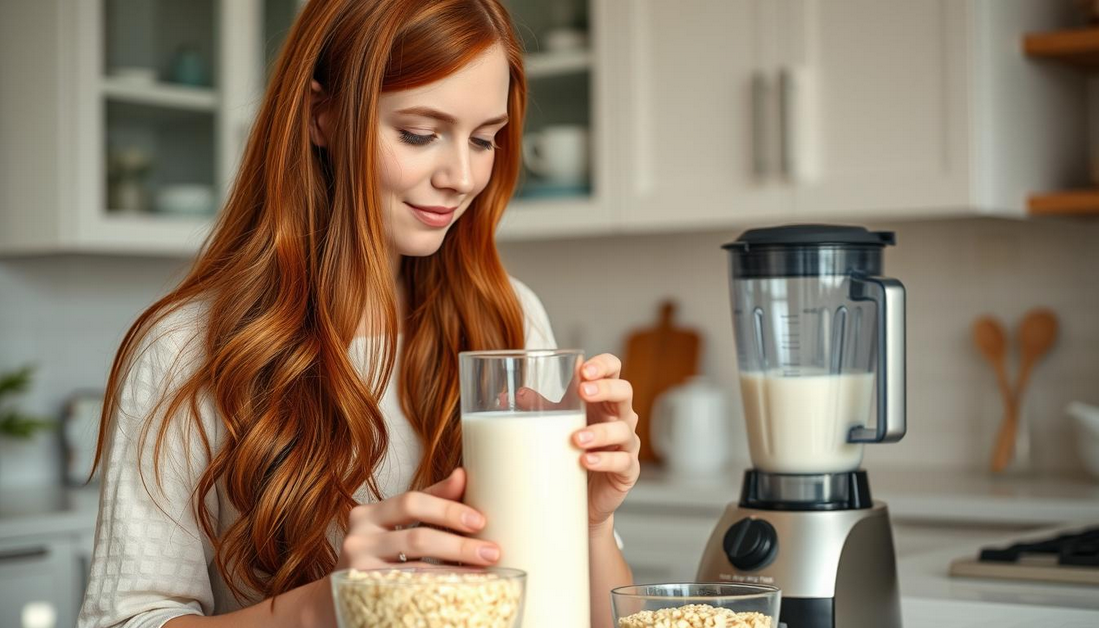India customers to view on amazon.in
Step-by-Step Guide to Making Oat Milk Yourself
Homemade oat milk is becoming a staple in many kitchens, and for good reason. With its creamy texture and versatile uses, it’s no wonder that people are ditching store-bought milk for a DIY approach.
- The Rise of Oat Milk: Why Everyone’s Going Nuts for Non-Nuts
- Health Benefits of Switching to Homemade Oat Milk
- Nutritional Profile of Oat Milk
- Comparing Oat Milk to Other Plant-Based Alternatives
- Who Benefits Most from Drinking Oat Milk
- What You’ll Need: Ingredients & Equipment Checklist
- Basic Ingredients for Simple Oat Milk
- Optional Add-ins for Flavor and Nutrition
- Essential Equipment for Perfect Results
- Oat Yeah! This DIY Oat Milk Is Taking Over Kitchens
- Why Homemade Beats Store-Bought Every Time
- Cost Comparison: DIY vs. Commercial Brands
- Environmental Impact of Making Your Own
- Step-by-Step: The Ultimate Oat Milk Recipe
- Storage Tips for Keeping Your Oat Milk Fresh
- Troubleshooting Common Oat Milk Problems
- Flavor Variations to Keep Things Exciting
- Sweet Options: Vanilla, Chocolate, and More
- Savory Possibilities for Cooking
- Seasonal Flavor Inspirations
- Creative Ways to Use Your Homemade Oat Milk
- Zero-Waste Kitchen: What to Do with Leftover Oat Pulp
- Conclusion: Your Journey to Oat Milk Mastery
- FAQ
- What is the best type of oats to use for making oat milk?
- How do I prevent my oat milk from becoming slimy or gelatinous?
- Can I make oat milk without a blender?
- Is homemade oat milk suitable for those with nut allergies?
- How long does homemade oat milk last?
- Can I use oat milk as a 1:1 substitute in recipes that call for dairy milk?
- What are some creative ways to use oat pulp?
- How can I make my oat milk creamier?

Making your own oat milk at home is surprisingly simple. All you need is a few ingredients, including oats, water, and a sweetener of your choice. This dairy-free milk alternative is perfect for those with dietary restrictions or preferences.
As the demand for vegan milk continues to grow, homemade oat milk is leading the charge. With its numerous benefits and ease of preparation, it’s no wonder that this oat milk recipe is taking over kitchens across the country.
Key Takeaways
- Homemade oat milk is a simple and delicious alternative to store-bought milk.
- This dairy-free milk is perfect for those with dietary restrictions or preferences.
- Making oat milk at home requires just a few ingredients and is easy to customize.
- Oat milk is a versatile ingredient that can be used in a variety of recipes.
- The demand for vegan milk is on the rise, with homemade oat milk leading the way.
The Rise of Oat Milk: Why Everyone’s Going Nuts for Non-Nuts
The oat milk phenomenon has taken the world by storm, offering a delicious and sustainable alternative to traditional dairy. As we explore the reasons behind its popularity, it becomes clear that oat milk is more than just a trend.
A Brief History of Oat Milk’s Popularity
Oat milk has been around for decades, but its recent surge in popularity can be attributed to the growing demand for plant-based products. Initially, it was a niche product found in specialty stores, but it has now become mainstream, available in most supermarkets. This shift is largely due to consumers becoming more environmentally conscious and seeking dairy-free alternatives.
Environmental Benefits of Choosing Oat Milk
One of the primary reasons oat milk has gained popularity is its environmental benefits. Unlike traditional dairy farming, which is a significant contributor to greenhouse gas emissions, oat milk production has a much lower carbon footprint. Here are some key environmental benefits:
- Lower Water Usage: Oat milk requires significantly less water to produce compared to dairy milk.
- Reduced Land Use: Oats can be grown in a variety of conditions and do not require large areas of grazing land.
- Sustainable Production: Oat milk production generates less waste and pollution compared to traditional dairy.

By choosing oat milk, consumers are supporting a more sustainable food system. As the demand for eco-friendly products continues to grow, oat milk is likely to remain a popular choice among those looking for a dairy-free alternative.
Health Benefits of Switching to Homemade Oat Milk
Homemade oat milk offers numerous health benefits that are worth exploring. By making oat milk at home, you can control the ingredients and customize it to your dietary needs.
Nutritional Profile of Oat Milk
Oat milk is a nutrient-rich beverage that provides several essential vitamins and minerals. Its nutritional profile makes it an attractive option for those looking for a dairy-free alternative.
Key Vitamins and Minerals
Oat milk is often fortified with calcium, vitamin D, and vitamin B2, making it a good source of these essential nutrients. These vitamins and minerals are crucial for maintaining strong bones and overall health.
Fiber Content and Digestive Benefits
Oat milk contains soluble fiber, which can help with digestion and promote a healthy gut. A diet rich in fiber can also help lower cholesterol levels and improve heart health.

Comparing Oat Milk to Other Plant-Based Alternatives
Oat milk stands out among other plant-based milks due to its creamy texture and environmental benefits. Compared to almond milk, oat milk generally has a lower environmental impact and is more sustainable.
Who Benefits Most from Drinking Oat Milk
Certain groups can particularly benefit from incorporating oat milk into their diet. These include individuals with dairy allergies or lactose intolerance, as well as those following a vegan lifestyle.
Dairy Allergies and Lactose Intolerance
For those with dairy allergies or lactose intolerance, oat milk provides a safe and comfortable alternative. It’s naturally free from dairy, making it an excellent choice for sensitive stomachs.
Vegan and Plant-Based Lifestyles
Vegans and individuals following a plant-based diet can also benefit from oat milk. It’s a versatile ingredient that can be used in various recipes, from smoothies to baked goods.
What You’ll Need: Ingredients & Equipment Checklist
To make oat milk at home, you’ll need a few simple ingredients and some basic kitchen equipment. Let’s break down what’s essential for getting started.
Basic Ingredients for Simple Oat Milk
To make basic oat milk, you’ll need just a couple of ingredients: oats and water. You can use either rolled oats or steel-cut oats, though rolled oats are more common for oat milk due to their softer texture.
Optional Add-ins for Flavor and Nutrition
You can enhance your oat milk with various add-ins. Consider adding a pinch of salt, a drizzle of honey, or a sprinkle of cinnamon to give your oat milk a unique flavor. For added nutrition, you might include a scoop of your favorite protein powder or a spoonful of chia seeds.
Essential Equipment for Perfect Results
Having the right equipment is crucial for making great oat milk. You’ll need a blender to break down the oats and a strainer to separate the milk from the pulp.
Blender Options and Recommendations
For blending oats, a high-speed blender like a Vitamix or Blendtec is ideal. However, any standard blender will do in a pinch.
Straining Tools Comparison
You have a couple of options for straining your oat milk: a nut milk bag or a fine-mesh sieve. Both work well, but a nut milk bag can be more convenient for straining.
| Tool | Ease of Use | Effectiveness |
|---|---|---|
| Nut Milk Bag | Easy | High |
| Fine-Mesh Sieve | Moderate | High |

Oat Yeah! This DIY Oat Milk Is Taking Over Kitchens
Switching to homemade oat milk can be a simple yet effective way to make your diet more sustainable. With the rise of plant-based diets, oat milk has become a staple in many kitchens. Making it at home allows you to control the ingredients, flavor, and texture, ensuring it meets your dietary needs and preferences.

Why Homemade Beats Store-Bought Every Time
Homemade oat milk offers several advantages over store-bought versions. For one, you can control the amount of sugar and additives that go into your milk. Many commercial brands add thickeners and preservatives to extend shelf life, which can be avoided by making it at home. Moreover, homemade oat milk can be customized to your taste preferences, allowing you to experiment with different flavors and sweeteners.
Customization is key when it comes to enjoying oat milk. Whether you prefer it sweet, creamy, or flavored, making it at home gives you the flexibility to adjust the recipe to your liking.
Cost Comparison: DIY vs. Commercial Brands
One of the most significant benefits of making oat milk at home is the cost savings. A bag of oats can cost as little as $3 and can make several liters of milk, depending on the recipe. In contrast, a liter of commercial oat milk can range from $4 to $6. By making it at home, you can save up to 50% on your oat milk expenses.
Here’s a rough estimate of the cost comparison:
- 1 bag of oats (2.5 lbs): $3
- Homemade oat milk yield: approximately 4-6 liters
- Cost per liter: $0.50-$0.75
- Commercial oat milk per liter: $4-$6
Environmental Impact of Making Your Own
Making oat milk at home also has a positive environmental impact. By choosing oats, which are generally more sustainable than almond or soybeans, you’re already making an eco-friendly choice. Furthermore, by making it at home, you can reduce packaging waste associated with commercial oat milk. You can also opt for using reusable containers for storing your homemade oat milk, further minimizing your carbon footprint.
Step-by-Step: The Ultimate Oat Milk Recipe
With just a few easy steps, you can create delicious and creamy oat milk in the comfort of your own kitchen. Making oat milk at home allows you to control the ingredients, flavor, and consistency to your liking.
Preparing Your Oats
The first step in making oat milk is preparing your oats. This involves deciding whether to soak your oats and measuring them for the perfect consistency.
To Soak or Not to Soak
Soaking your oats can help reduce phytic acid and make the milk easier to digest. However, it’s not strictly necessary, and you can skip this step if you’re short on time.
Measuring for Perfect Consistency
The ratio of oats to water will determine the creaminess of your oat milk. A general rule of thumb is to use 1 cup of oats to 2-3 cups of water.
Blending Process for Optimal Creaminess
The blending process is crucial for achieving the right consistency and flavor. This involves an initial blend, adding flavorings, and a final blending.
Step1: Initial Blend
Start by blending your oats and water mixture on high speed for about 1-2 minutes, until the oats are fully broken down.
Step2: Adding Flavorings
If you’re adding flavorings like vanilla or cinnamon, now is the time to do it. This will help distribute the flavors evenly throughout the milk.
Step3: Final Blending Time
Blend the mixture for another minute or until it’s smooth and creamy. Be careful not to over-blend, as this can create foam.

Straining Techniques for Smooth Results
Straining your oat milk is essential for removing any remaining oat pulp and achieving a smooth texture. There are several methods you can use.
Using a Nut Milk Bag
A nut milk bag is a great tool for straining oat milk. Simply pour the blended mixture into the bag and squeeze out as much milk as possible.
Alternative Straining Methods
If you don’t have a nut milk bag, you can use a fine-mesh sieve or cheesecloth to strain your oat milk.
How Much to Strain for Different Uses
The amount of straining you need to do will depend on how you plan to use your oat milk. For example, if you’re using it in coffee, you may want to strain it more thoroughly to remove any remaining pulp.
| Use | Straining Method | Result |
|---|---|---|
| Coffee or Tea | Nut milk bag or fine-mesh sieve | Smooth, creamy milk |
| Baking or Cooking | Cheesecloth or coarse sieve | Thicker, more textured milk |
| Smoothies or Shakes | Minimal straining or blending again | Creamy, pulpy texture |
“The key to making great oat milk is to experiment with different ratios of oats to water and straining methods until you find what works best for you.”
— Oat Milk Enthusiast
Storage Tips for Keeping Your Oat Milk Fresh
Maintaining the quality of your oat milk requires careful consideration of storage methods. Proper storage not only preserves the taste but also extends the shelf life of your homemade oat milk.
Proper Containers and Temperature
The type of container you use can significantly impact the freshness of your oat milk. It’s recommended to store oat milk in airtight glass containers to prevent contamination and exposure to air, which can cause it to spoil faster. Glass containers are preferred over plastic as they are non-porous and don’t retain flavors or odors. Store your oat milk in the refrigerator at a temperature below 40°F (4°C) to slow down bacterial growth.

Shelf Life Expectations
Homemade oat milk typically lasts for 3 to 5 days when stored properly in the refrigerator. It’s essential to check on it regularly for any signs of spoilage. The shelf life can vary depending on factors like the freshness of the oats used, the cleanliness of the equipment, and how well the container is sealed.
Signs Your Oat Milk Has Gone Bad
If your oat milk has gone bad, it may exhibit a sour smell, a slimy texture, or an off taste. Visible mold or curdling are also clear indicators that it’s time to discard the oat milk. Regularly inspecting your oat milk for these signs ensures you consume it while it’s still fresh and safe.
Troubleshooting Common Oat Milk Problems
Oat milk enthusiasts often encounter a few common issues, but these can be easily resolved with the right techniques. Making oat milk at home is a process that requires some finesse, but with a few adjustments, you can achieve the perfect blend.
Preventing the Dreaded “Slimy” Texture
A slimy texture is often the result of improper straining or using the wrong type of oats. To avoid this, use rolled oats or old-fashioned oats instead of steel-cut oats, as they blend more smoothly. Ensuring that you’re straining your oat milk through a fine enough mesh or cheesecloth can also help prevent slimy textures.

Solutions for Separation Issues
Separation is a common issue with oat milk, but it can be easily addressed. One solution is to add a natural emulsifier like lecithin or a pinch of salt to help keep the mixture stable. Additionally, shaking your oat milk well before use can help re-emulsify the ingredients.
| Issue | Solution |
|---|---|
| Slimy Texture | Use rolled oats and strain through a fine mesh. |
| Separation | Add lecithin or salt, and shake well. |
Fixing Flavor Problems
If your oat milk tastes off or unpleasantly sweet, it might be due to the quality of the oats or the water used. Using fresh, high-quality oats and filtered water can significantly improve the flavor. You can also experiment with adding flavorings like vanilla or cinnamon to mask any unwanted tastes.
“The key to great-tasting oat milk is using the right ingredients and being mindful of the blending and straining process.”
By addressing these common issues, you can enjoy a smooth, creamy, and delicious homemade oat milk that rivals store-bought versions.
Flavor Variations to Keep Things Exciting
Homemade oat milk is not just a healthy alternative; it’s also a canvas for your favorite flavors. With a few simple additions, you can transform your basic oat milk into a deliciously unique beverage.
Sweet Options: Vanilla, Chocolate, and More
Sweet flavors are a great way to start your oat milk journey. You can create a variety of sweet options by adding different ingredients.
- Classic Vanilla: Add a hint of vanilla extract for a creamy, comforting taste.
- Chocolate Delight: Blend in some cocoa powder or melted chocolate for a decadent treat.
- Maple-Cinnamon: Mix in a drizzle of maple syrup and a sprinkle of cinnamon for a warm, sweet flavor.
Classic Vanilla Oat Milk
Add a teaspoon of vanilla extract to your oat milk for a classic, comforting flavor.
Chocolate Oat Milk for Treats
Blend in 2 tablespoons of cocoa powder to create a rich, chocolatey oat milk perfect for treats.
Maple-Cinnamon Variation
Mix in 1 tablespoon of maple syrup and a pinch of cinnamon for a warm, sweet flavor.
Savory Possibilities for Cooking
Oat milk isn’t just for drinking; it’s also a versatile ingredient for cooking. Use it as a base for savory dishes by adding herbs and spices.
For example, you can create a savory oat milk by adding garlic, salt, and herbs like parsley or thyme. This can be used in soups, stews, or as a creamy sauce for pasta or vegetables.
Seasonal Flavor Inspirations
Change up your oat milk flavors with the seasons to keep things interesting.
- Summer Refreshers: Try adding citrus zest or juice, like lemon or orange, for a refreshing twist.
- Fall and Winter Warmers: Spice things up with cinnamon, nutmeg, or ginger for a warm, comforting flavor.
- Spring Flavor Combinations: Mix in some fresh mint or berries for a light, refreshing taste.
Summer Refreshers
Add a squeeze of fresh lemon juice and a bit of zest for a refreshing summer drink.
Fall and Winter Warmers
Blend in some cinnamon and nutmeg for a warm, spicy flavor perfect for the colder months.
Spring Flavor Combinations
Mix in some fresh mint leaves and a handful of berries for a light, refreshing oat milk.

Creative Ways to Use Your Homemade Oat Milk
Homemade oat milk is not just a dairy alternative; it’s a versatile ingredient that can elevate various aspects of your culinary adventures. With its creamy texture and subtle flavor, oat milk can be used in a variety of dishes, from beverages to baked goods.
Coffee and Tea Applications
Oat milk is a fantastic addition to coffee and tea, offering a creamy texture without the dairy. It’s particularly popular in lattes and cappuccinos.
Creating Barista-Style Foam
To create barista-style foam, you can use a frother or a blender to froth the oat milk until it becomes creamy and foamy.
Temperature Tips for Coffee Drinks
For the best flavor, it’s essential to heat the oat milk to the right temperature. Ideally, it should be steaming hot but not boiling.
Baking Applications and Adjustments
Oat milk can be used as a substitute for dairy milk in baking, offering a moist and delicious texture to cakes, muffins, and cookies. When using oat milk in baking, you may need to adjust the liquid content and possibly add more leavening agents.
Smoothies, Soups, and Sauces
Oat milk is also a great base for smoothies, adding a creamy texture. It can be used in soups for a dairy-free creamy base, and in sauces, it provides a subtle flavor.
Zero-Waste Kitchen: What to Do with Leftover Oat Pulp
Oat pulp, the byproduct of oat milk production, is more than just waste; it’s a valuable resource for baking, beauty, and more. Instead of throwing it away, you can repurpose it in various creative ways, contributing to a zero-waste kitchen.
Baking with Oat Pulp
One of the most straightforward ways to use oat pulp is in baking. It adds fiber and texture to baked goods, making them more nutritious and delicious.
Oat Pulp Cookies Recipe
Mix oat pulp with your favorite cookie ingredients, like nuts and chocolate chips, for a tasty treat that’s both healthy and environmentally friendly.
Adding to Bread and Muffins
Incorporate oat pulp into your bread and muffin recipes to enhance their nutritional profile and texture.
Beauty and Household Applications
Oat pulp can also be used in beauty treatments and around the house. It can be used as a natural exfoliant in face masks or as a component in homemade scrubs.
Composting and Garden Uses
If you have a garden, you can compost oat pulp and use it as a nutrient-rich fertilizer. This practice not only reduces waste but also enriches your soil naturally.
By finding new uses for oat pulp, you’re not only reducing kitchen waste but also adding value to your homemade oat milk. Get creative and make the most out of your oat milk production process.
Conclusion: Your Journey to Oat Milk Mastery
As we’ve explored the world of homemade oat milk, it’s clear that making the switch can be a game-changer for your kitchen and the environment. With Oat Yeah! This DIY Oat Milk Is Taking Over Kitchens, you’re not just adopting a new recipe – you’re embracing a sustainable lifestyle.
Achieving oat milk mastery is within your reach. By following the simple steps outlined in this article, you can create delicious, creamy homemade oat milk that’s tailored to your taste preferences. Whether you’re looking to reduce your environmental footprint or simply want a healthier alternative to commercial brands, DIY oat milk is an excellent choice.
So why not give it a try? Start your oat milk journey today and experience the benefits of this versatile, plant-based milk alternative. With a little practice, you’ll be whipping up batches of creamy, dreamy oat milk like a pro, enjoying the rewards of oat milk mastery in your daily cup.







